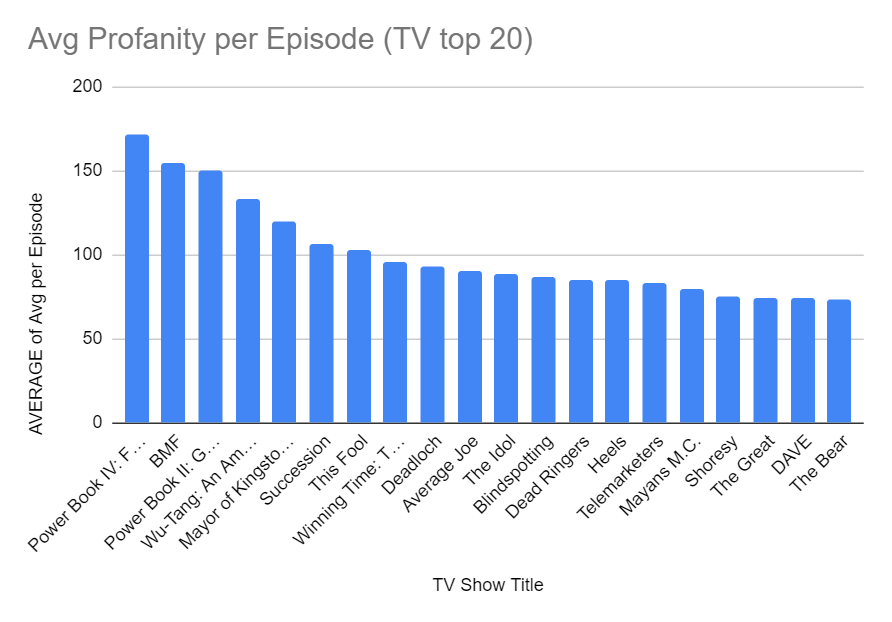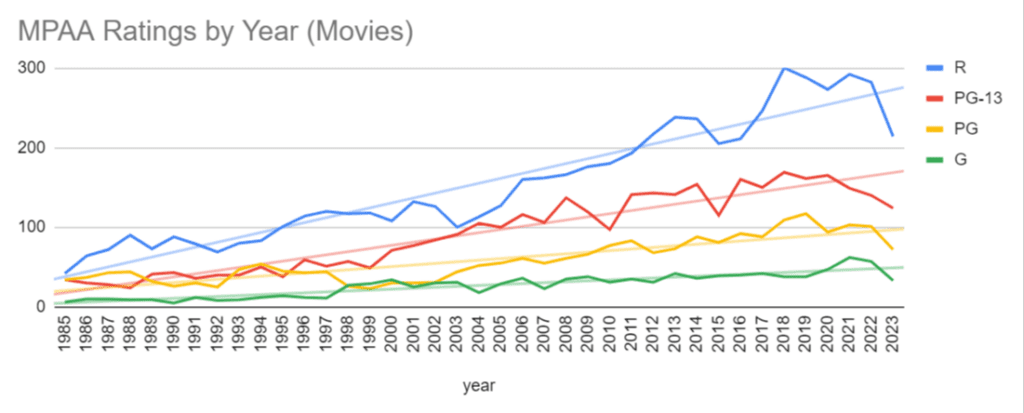An Upward Trajectory of On-Screen Profanity Reflects Shifting Cultural Norms and MPAA Ratings
In recent years, there has been a notable intensification of the profanity trends on television shows and movies. This trend is emblematic of broader shifts in cultural norms and the entertainment industry’s response to consumer preferences. A detailed analysis of data from the past decades through 2023 uncovers a progressive rise in the usage of strong language across various forms of screen entertainment, with a particular uptick observed in 2022-2023. This screen entertainment analysis is based on a sampling of over 60,000 popular movies and TV shows, providing a robust snapshot of trends. This rise of profanity has also affected the MPAA ratings of new movies.[1]
The Evolution of Swear Words: A Quantitative Overview
The numbers speak volumes. In TV shows, 2022 marked a high point in using the “f…” word, with a staggering count of 17,801 instances, up from 13,261 in 2021.[1] This pattern is mirrored in the usage of “sh..” and other common swear words. This quantitative analysis indicates a broader liberalization in the language employed by characters on the small screen.[1]
Movies, while showing a lower overall frequency of profanity than TV shows, also showcased a similar trend in film profanity statistics. In 2022, the use of the “f…” word in films rose to 12,682 instances, a significant jump from the 8,842 occurrences documented in 2021.[1]


The Tides of MPAA Ratings: An Indicator of Content’s Evolution
The Motion Picture Association of America (MPAA) rating system has been a barometer for content maturity for decades, and its evolution of MPAA ratings has not gone unnoticed. Exploring the MPAA ratings’ impact on TV shows and movies unveils a parallel shift towards mature content. In 2023, the “TV-MA” rating, which denotes programming specifically designed to be viewed by adults, was assigned to 190 TV shows. This is a marked increase from the 105 count in 2017, and when put against the backdrop of the profanity data, it suggests a correlation between the language used and content rating[2].
The trend in movies echoes this development. The “R” rating, indicating restricted audiences, accounted for 282 films in 2022, a modest increase from 246 in 2017 but part of a sustained preference for R-rated content over the years. This aligns with the broader movie content regulation and the MPAA and profanity trends observed in the industry[2].
Connecting the Dots: Profanity and Maturity Ratings
The correlation between the rise in on-screen profanity and the tendency towards more mature ratings cannot be overlooked. It appears that as audiences become more accepting of strong language, producers are increasingly comfortable with scripts that reflect such vernacular, subsequently influencing MPAA ratings. The data suggests that the entertainment industry is responding to a consumer base less perturbed by profanity and, by extension, more mature content.[1][2]


The Year 2022-2023: A Profanity Inflection Point
The years 2022 and 2023 have been particularly noteworthy in the profanity landscape. Not only did these years witness a rise in strong language on-screen, but they also saw a surge in mature MPAA ratings for both TV shows and movies. This could indicate a cultural inflection point where mainstream entertainment is becoming more explicit and unfiltered than ever before.[1][2]
Analyzing the Aberrations
While 2022 and 2023 have been notable for their increase in the use of profanity, they also represent a period of profanity aberrations in production due to external factors. As such, while the data indicates an upward trend in the use of explicit language and mature content ratings, this trend must be contextualized within the wider industry disruptions of the COVID-19 pandemic and the 2023 writers’ strike. Understanding the reasons for profanity deviations and the audience’s perception of aberrations is crucial in interpreting these atypical periods in the entertainment industry[1][2].

Implications and the Path Forward
This burgeoning propensity for profanity in screen entertainment raises important questions about the role of media regulators, the responsibility of content creators, and the evolving thresholds of audiences. The data suggests that what was once considered taboo or restricted to late-night adult programming is now filtering into mainstream access. As entertainment mediums continue to converge and diversify with streaming services and on-demand content, the profanity landscape and MPAA ratings will likely continue their current trajectories, reflecting and shaping the zeitgeist of our times.
In conclusion, the analysis offers a clear-eyed view of the entertainment industry’s trajectory toward more liberal use of language and mature content. As society grapples with these changes, it’s imperative for content creators, regulators, and consumers to engage in dialogue about the implications of these trends and the way they mirror or influence contemporary culture and values.
[1] Data derived from a sampling of over 60,000 popular movies and TV shows.
[2] MPAA rating trends are based on a sampling of 100,000 popular movies and TV shows.





